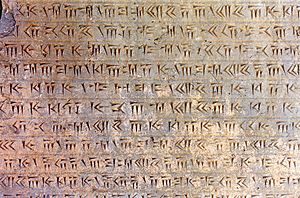Old Persian language facts for kids
Quick facts for kids Old Persian |
|
|---|---|
| Region | Ancient Iran |
| Extinct | Evolved into Middle Persian |
| Language family |
Indo-European
|
| Writing system | Old Persian Cuneiform |

The Old Persian language was an ancient language spoken during the time of the Achaemenid Empire. This powerful empire existed from around 600 BCE to 300 BCE. Old Persian is one of the oldest forms of the Persian that we have found.
We know about Old Persian because examples of its writing have been discovered. These writings are found in places that are now Iran, Iraq, Turkey, and Egypt. The language was written using a special system called Old Persian Cuneiform.
Contents
Where Old Persian Comes From
Old Persian belongs to a big family of languages called Indo-European. Think of it like a giant family tree! Within that tree, it's part of a smaller branch called Indo-Iranian. Even more specifically, it's an Iranian language.
Over time, languages change and evolve. Old Persian eventually changed into Middle Persian. Then, Middle Persian developed into what we now call New Persian, which is spoken today.
How Old Persian Words Sounded
Just like English, Old Persian had different sounds. These sounds are called phonemes. It had both vowels (like 'a', 'e', 'i', 'o', 'u') and consonants (like 'p', 't', 'k', 'm', 'n'). Some vowels were short, and some were long.
How Old Persian Grammar Worked
Old Persian grammar was quite structured. Words would change their endings depending on how they were used in a sentence.
Nouns in Old Persian
Nouns are words for people, places, or things. In Old Persian, nouns changed their endings based on their "stem" or base form. They also changed endings depending on if they were singular (one), dual (two), or plural (more than two). The endings also changed based on their role in the sentence, like who was doing the action or who the action was done to.
Verbs in Old Persian
Verbs are action words. In Old Persian, verbs also changed their endings. These changes showed who was doing the action (like "I" or "he"), and when the action happened (like present or past).
- Voices: Verbs could be in different "voices":
- Active: The subject does the action (e.g., "He built").
- Middle: The subject does the action to or for themselves.
- Passive: The subject receives the action (e.g., "It was built").
- Forms: Most of the time, Old Persian writings used forms for the first person (like "I" or "we") and the third person (like "he," "she," "it," or "they"). The "dual" form, meaning "both," was not used very often. One example we know is ajīvatam, which means 'both lived'.
Old Persian Words We Know
It's cool to see how words have changed over thousands of years! Here are some Old Persian words and how they compare to older and newer forms of the language:
| Ancient Root Word | Old Persian | Middle Persian | Modern Persian | Meaning |
|---|---|---|---|---|
| *açva | aspa | asp | asp اسپ | horse |
| *kāma | kāma | kām | kām کام | desire |
| *daiva | daiva | div | div دیو | devil (or evil spirit) |
| drayah | drayā | daryā دریا | sea | |
| dasta | dast | dast دست | hand | |
| *bhāgī | bāji | bāj | bāj باج/باژ | tribute (a payment to a ruler) |
| *bhrātr- | brātar | brādar | barādar برادر | brother |
| *bhūmī | būmi | būm | būm بوم | region, land |
| *martya | martya | mard | mard مرد | man |
| *māsa | māha | māh | māh ماه | moon, month |
| *vāsara | vāhara | Bahār | bahār بهار | spring (the season) |
| stūnā | stūn | sotūn ستون | column (like a pillar) | |
| šiyāta | šād | šād شاد | happy | |
| *arta | arta | ard | ord ارد | truth |
| *draugh- | drauga | drōgh | dorōgh دروغ | lie (something untrue) |
See also
 In Spanish: Persa antiguo para niños
In Spanish: Persa antiguo para niños
Images for kids
-
Close-up of the Behistun inscription, a famous Old Persian carving.


